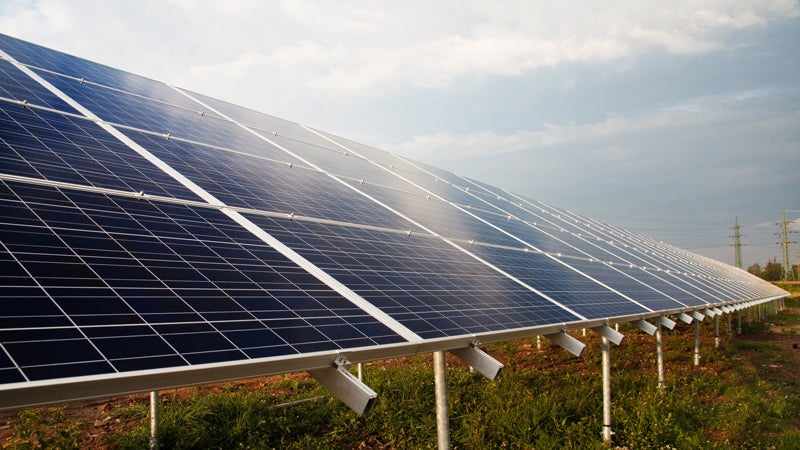IW energy task force report urges regulation of battery storage at solar farms
Published 8:08 pm Thursday, August 1, 2024

- Stock photo
A five-member energy task force that’s met monthly over the past year is urging Isle of Wight County supervisors to develop an ordinance regulating battery storage at solar farms before the issue hits home.
The report also contends the county’s existing ordinances are sufficient for utility-scale solar farms but overly restrictive when applied to smaller projects.
In 2022, Dominion Energy placed three utility-scale batteries at a solar farm in Powhatan County that are collectively capable of storing up to 16 megawatts of electricity. Dominion switched on the state’s largest array of batteries in 2023 in Chesterfield County, estimating storage of up to 20 megawatts, or enough to power 5,000 homes for up to four hours. The batteries are poised to generate $1.2 million annually in tax revenue for Chesterfield.
It’s a concept that hasn’t yet reached Isle of Wight, which has approved nine solar farms to date.
The task force, in a final report presented to the supervisors on Aug. 1, contends a “thoughtful and safe investment in battery storage will be a positive for the county as battery storage will dramatically increase the efficiency of solar energy and reduce the overall acreage requirements of future projects” – “thoughtful and safe” being the key words.
“We’re in favor of it, it just has to be done right,” said Lewis Edmonds, who represented the Windsor-centric District 4 on the task force.
“It is critical that strict ordinances are in place before proposed battery storage developments come calling to Isle of Wight,” the task force’s report states. “The cost involved in these preventative measures may not be popular with some developers, but it will be in the best long-term interest of the county.”
One of the challenges the task force identified is that emergency preparedness hasn’t kept pace with advances in solar farms and on-site battery storage. Protocol to date, according to task force chairwoman Lynn Briggs, has been to wait for electrical fires to burn themselves out.
Isle of Wight supervisors had appointed the task force members in 2023 on the recommendation of its Planning Commission, which in 2022 urged a review of the county’s remaining high-voltage transmission line capacity to absorb an influx of solar farm proposals and other emerging electricity generation technologies.
“Modeling energy production growth capacity is difficult due to proprietary protections on available transmission line capacity,” the task force’s report states, asserting that “establishing goals associated with particular types of energy production in the county is not advised.”
The county’s existing ordinances regulating solar farms, including one supervisors adopted last year setting a 2,446-acre, or 2%, cap on the cumulative amount of prime farmland devoted to solar panels, “are effective at managing utility-scale solar” farms that feed their generated electricity into Dominion’s power grid, the report states. The nine Isle of Wight solar farms approved to date collectively account for roughly 2,200 acres of prime farmland.
The report, however, contends existing ordinances are too restrictive when it comes to “community scaled” solar farms — smaller-scale operations where an electric utility company pays a solar provider for the energy generated, and each of the solar provider’s local subscribers receives a credit on his or her electric bill for their participation.
The task force also evaluated other forms of electricity generation besides solar, including hydroelectric, wind, natural gas and prototype small modular nuclear reactors, or SMRs, concluding “geographic and climate factors make Isle of Wight uncompetitive for hydroelectric and wind power.”
Columbia Gas Transmission LLC, a subsidiary of Canada-based TC Energy unaffiliated with Columbia Gas of Virginia, received federal approval last year for what the company has termed its “Virginia Reliability Project,” which will entail replacing an existing 1950s-era 12-inch natural gas pipeline that passes through Isle of Wight, Surry and Southampton counties and the city of Suffolk with a 24-inch one to meet growing demand for natural gas across Hampton Roads.
However, “Hampton Roads is at the end of the pipeline, which creates restrictions on natural gas growth,” the report states. “Also, Virginia’s policies over the past 10 years have mostly tilted against non-renewable energy production, which makes natural gas investment risky for private investors.”
Gov. Glenn Youngkin’s 2022 energy plan calls for at least one SMR in Virginia within the next decade. To date, they have been used since the 1950s on naval vessels but haven’t been utilized on land in the United States. Surry County supervisors in February approved rezoning for a prototype SMR-powered data center and hydrogen fuel hub campus, which the project’s Middleburg-based developer, Green Energy Partners, expects to build in phases over the next 13 years on land adjacent to Dominion Energy’s Surry nuclear power plant.
Dominion announced in July it would solicit proposals from leading SMR nuclear technology companies to evaluate the feasibility of developing an SMR at North Anna, the newer of the state’s two nuclear plants, which began operating in 1978 in Louisa County. The Surry plant, which is nearly identical, began operating its first reactor six years earlier in 1972.
“Isle of Wight County’s proximity to Surry may provide indirect opportunities, such as supporting industry or workforce housing,” the task force report states.





